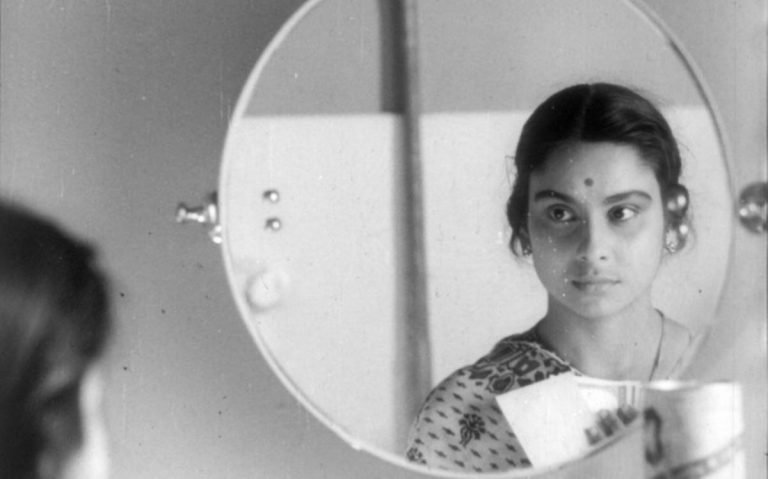The story of a tribal woman from Jharkhand, working as a data labeler to train AI models—how appealing is that premise for you? Perhaps for a film, you would expect something brimming with surface-level intrigue, or a pretentious and predictable tale of empowerment. However, “Humans in the Loop” (2024) will certainly defy all such expectations through its profound narrative. They say simplicity is the ultimate sophistication, and in “Humans in the Loop,” Aaranya Sahay— his debut feature—effortlessly synthesizes intricate details into a truly exquisite, layered, and poignant gem. As we contemplate ‘Brain Rot’ as Oxford’s Word of the Year, the film offers a compelling perspective on transformative human-technology interactions through a transcendently affectionate, deeply thoughtful, political, and philosophical narrative—one that is not merely abstract but firmly grounded in reality.
The central character in the film, Nehma, is called a ‘dhukni’ (a woman partner in a dhuku marriage), while ‘Dhuku’ marriages are considered a social bane among the tribals in Jharkhand. These are live-in relationships that lack social acceptance, as they fail to organize wedding parties. Reports suggest there are thousands of such couples among the tribal people. The practice itself signifies poverty and patriarchal norms within the community.
Nehma has now returned to her village with her infant child and a 12-year-old daughter, after divorcing her upper-caste husband. To claim guardianship of her daughter, she begins working as a data labeler at a local Artificial Intelligence center in the village. Her job involves labeling objects appearing in given photos or videos to make AI learn, recognize, and differentiate. As a single mother living under social taboo, she must not only navigate everyday struggles but also deal with her estranged daughter, who wishes to return to her father and live in the city.

The story itself juxtaposes artificial intelligence—currently a pinnacle of technological advancement—with the indigenous tribal community —a representation of the underprivileged. Nehma’s job as a data labeler enables the interaction between these two worlds. On the one hand, her role in training AI highlights how integral her indigenous knowledge is to modern technological systems on multiple occasions. On the other hand, this interaction with modernity provides her with dignity and a newfound sense of self-reliance. The narrative masterfully reveals how these seemingly disparate realms can coexist, showing their mutual dependence.
Back in 2022, in her acceptance speech at the Emmy Awards, Lizzo, the famous American pop singer, went emotional as she shared a heartfelt reflection. She spoke about how, as a child, she wanted to see people like herself in the media—people who were fat like her, Black like her, and beautiful like her (as she proudly mentioned). Her words underscore the significance of representation in media, ensuring no one feels alienated or unseen. “Humans in the Loop” echoes this sentiment through a pivotal sequence where the AI initially generates images of tribal people in Jharkhand based on prompts, creating unrealistic and stereotypical portrayals. However, when the AI is trained with accurate and authentic accounts, it begins to produce nuanced and realistic depictions, emphasizing the need for truthful representation in all spheres, including technology. Also, representation in social construction thrives on inclusion and defies unhealthy dominant narratives.
Albert Bandura’s Social Learning framework has explored how individuals learn through observation, imitation, and the interaction between personal, behavioral, and environmental factors. Interestingly, the filmmaker has drawn parallels between human learning with AI. As the daughter adapts and roams around the village, she is exposed to indigenous living and knowledge, much like how Nehma trains AI models. Both instances reflect the idea of learning through social constructions—AI, similar to a child, absorbs and adapts to the data it encounters. In an interesting sequence, while Nehma is asked to label something as a pest, her indigenous knowledge challenges it. By understanding the organism’s benefits to the plant, she provides a more nuanced perspective, allowing the possibility to reshape and rebuild biased misinformation (social constructs). This revelation about bias compels her to confront a similar issue within herself. This, in turn, helps soothe her relationship with her daughter.

Within a short duration of 72 minutes, the film is structured into three chapters, and the screenplay is pretty refined in its final draft, where nothing seems to have gone more than enough. The layered narrative uses leitmotifs and plot devices, keeping payoffs carefully under watch, including a post-credit shot that adds to the narrative. These equations remain organic as we are made to empathize with the characters. The technical aspects complement the seamless flow.
Jane Schoenbrun’s “I Saw the TV Glow” has created a buzz earlier this year for its interesting commentary on the media-induced echo chambers in a digitally enabled world, where people struggle to distinguish between reality and media-created reality. In a distinctly recognizable geographic and socio-cultural setting, Aaranya Sahay documents the radical shifts brought about by technology, paving the way for the empowerment of marginalized communities, in a country where the digital divide remains significant.
“Humans in the Loop” was produced through the Storiculture Impact Fellowship to bring attention to stories about responsible technologies in India. It premiered at the Mumbai Film Festival (MAMI) this year and was later screened under the Indian Cinema category at the International Film Festival of Kerala (IFFK).








